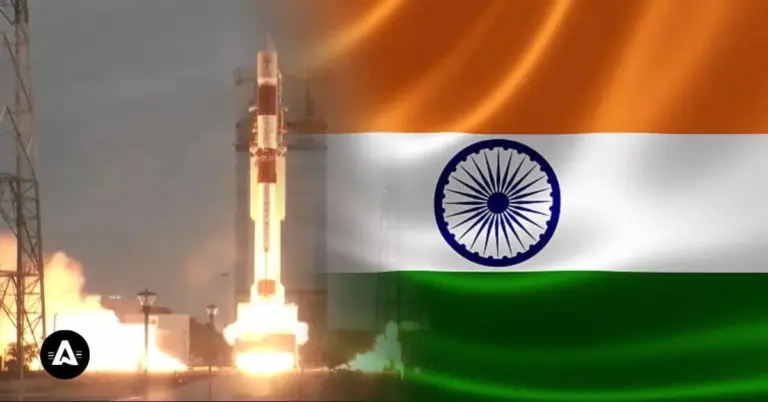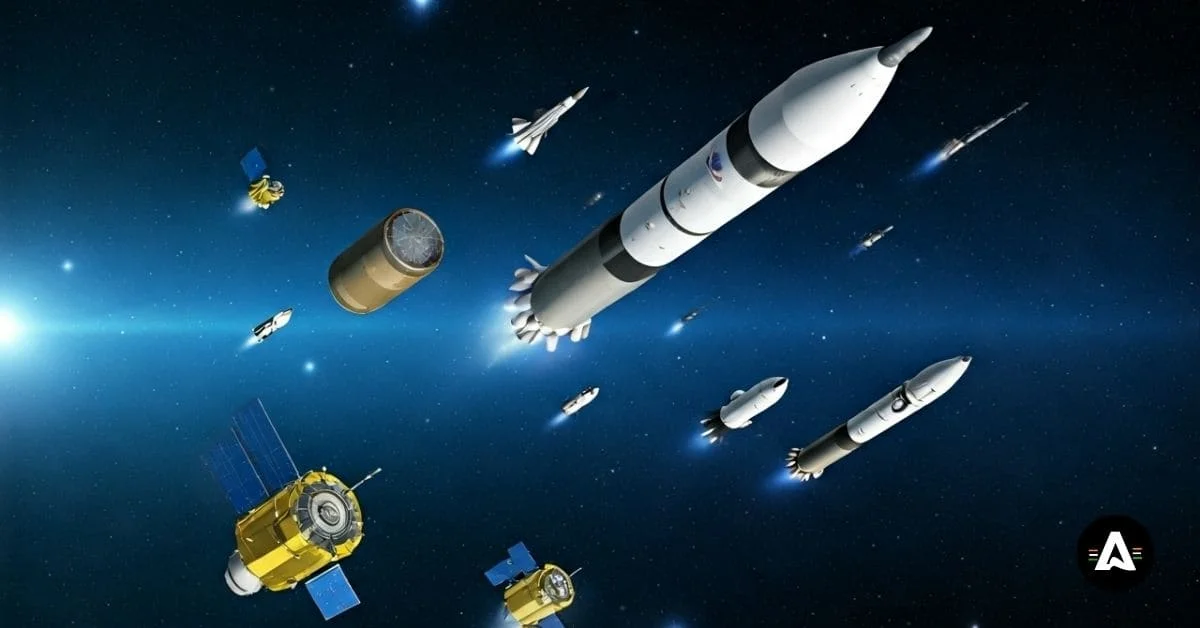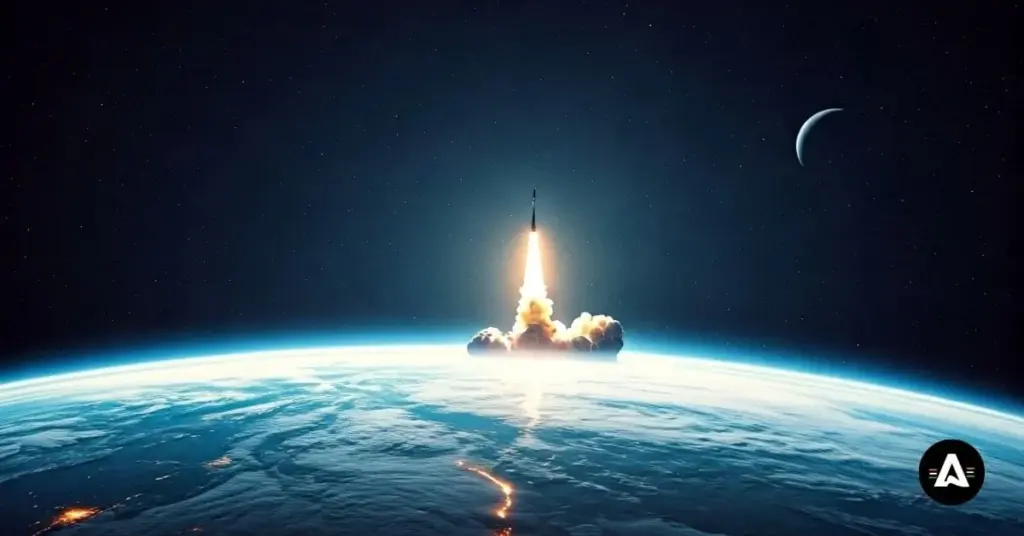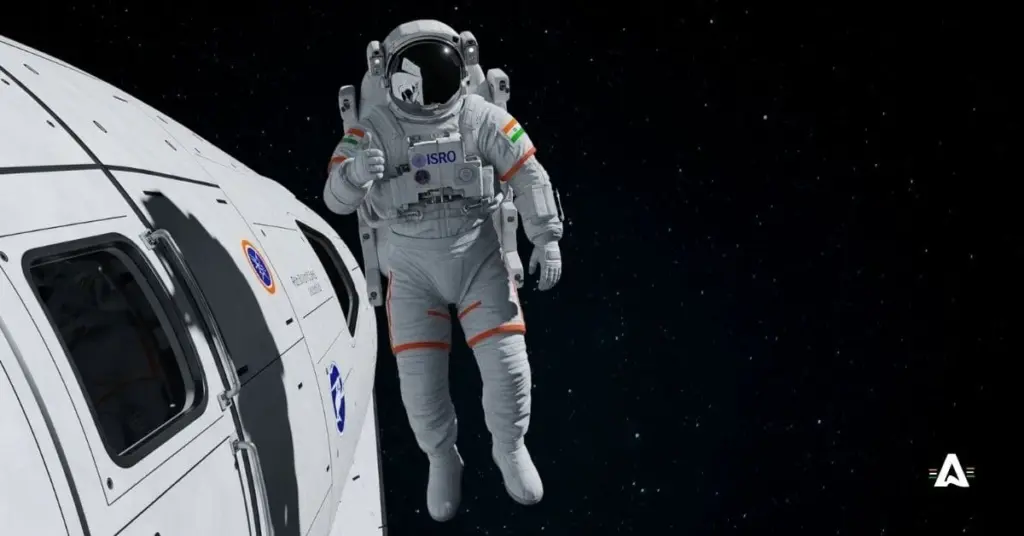List of ISRO Missions (1950–2025) and beyond

The list of ISRO missions below shows how the agency moved from early satellite launches to big interplanetary projects.
The Indian Space Research Organisation (ISRO) is India’s national space research organisation. It has started hundreds of important space missions. These missions help with scientific work, support national development, and push the development of related technologies. ISRO uses the Satish Dhawan Space Centre for most of this work. It is also the main development arm of the Department of Space.
ISRO sent Aryabhata, the first satellite from India, into space in 1975. This started India’s modern journey in space exploration.
ISRO completed big missions like the Mars Orbiter Mission (Mangalyaan) and Chandrayaan. These space missions have helped India earn a name on the world stage in space exploration.
The Indian Space Research Organisation works in areas of remote sensing, indigenous satellite navigation systems, and cost-effective technologies needed for space missions.
New and exciting ISRO programs are planned, like Gaganyaan, which will be India’s first manned space mission, and Shukrayaan, the Venus Orbiter mission.
Introduction
The Indian Space Research Organisation (ISRO) is the main space research organisation in India. It was started in 1969, with the help and support of the Prime Minister of India. ISRO’s first leader, Dr. Vikram Sarabhai, helped set strong goals for the new agency. He wanted to use space technology to bring good changes and development to the country. ISRO has worked hard in space exploration and space research since then. Over time, the Indian space research organisation has made several key achievements. A big one for ISRO was the Mars Orbiter Mission, also called Mangalyaan. This showed people everywhere that India can do great work in space and use new space technology for the future.
ISRO is India’s main space agency. Its work is not just about space missions. ISRO helps build communication satellites and weather forecasting tools. It also uses remote sensing, which helps in many different fields. ISRO is always working to find new and better ways to do things in science. In the future, ISRO is set to reach even bigger goals.
ISRO works on big projects and helps spark new ideas for the next wave of scientists and engineers. Because of this, ISRO has become one of the top names in space exploration. ISRO also makes the Indian people feel proud and gives them the drive to keep working towards sending missions to Mars and other places in space.
Comprehensive List of ISRO Missions (1950–2025) and Beyond
When you look at the full journey of the Indian Space Research Organisation, you see many big moments in space research and space exploration. Each step, from satellite launches to trips to the moon, has helped to make space technology better for all. This group has done important projects. A few of these are the Mars Orbiter Mission and several other spacecraft missions used for remote sensing and for checking what is in the air around Earth. Looking to the future, there will be new projects that hope to improve international space cooperation. This will also open up more chances for research in space. These plans will help ISRO keep its role as a top team in space technology and space research. The Indian space research organisation is well-known for its spacecraft missions, like the Mars Orbiter, and is respected across the globe for its work in space exploration.
1. Early Satellite Launches: Aryabhata, Bhaskara, and Rohini Series
ISRO, also known as the Indian Space Research Organisation, started its space exploration journey when it launched Aryabhata in 1975. This was India’s first man-made satellite. Even with the early technology at that time, Aryabhata was very important. The satellite helped bring new ideas to how a spacecraft can be made. Aryabhata gave important information that helped India grow in the space research organisation field and guided future missions for the Indian isro.

After Aryabhata did well, ISRO brought out the Bhaskara satellites to help with remote sensing and earth observation. Bhaskara-I went into space in 1979. It played a big part in making weather forecasting better and helped in farming, too. This showed how much progress India and ISRO made in space technology.
In 1980, ISRO started the Rohini series. The team sent satellites into space using India’s first made-in-the-country satellite launch vehicle. These Rohini missions showed that India got better at using sounding rockets and handling what goes up during space operations. The early work built a strong base for ISRO in space science. It also helped India get better at making and using satellite launch vehicles and spacecraft.
2. Landmark Missions: Chandrayaan, Mars Orbiter, and Astrosat
The Chandrayaan missions have had a big impact on lunar exploration and India’s space program. In 2008, India launched Chandrayaan-1. This was the country’s first successful mission to get to the Moon’s orbit. It also led to the discovery of water molecules on the Moon’s surface. This important finding changed what we know about the Moon and what it is made of. It also helped India become an important part of global space research.
After Chandrayaan-1, Chandrayaan-3 made a big mark by making a safe landing on the Moon in 2023. This moment was an important win for the Indian Space Research Organisation (ISRO). It showed the world that ISRO is a strong name in lunar orbit and space exploration. Many people around the world praised the Indian space research organisation for this. It made others trust ISRO even more, because of how well the team planned each step and how the technology worked during the mission.
Another great achievement for ISRO is the Mars Orbiter Mission, which many people call Mangalyaan. It was launched in 2013. With this project, India became the first Asian nation to reach the orbit of Mars. Mangalyaan sent back useful information about Mars’ atmosphere, and it did this with a budget far lower than most similar missions. The data collected from the Mars Orbiter Mission has helped us learn a lot about Mars and how other planets work.
In 2015, Astrosat was sent into space. It became India’s first special observatory in space. Astrosat has helped India and others study many things about space. People use it to look at black holes, cosmic rays, how stars change, and the solar corona. These big steps show that India is growing in the field of space exploration. The country can work well with other nations. This teamwork helps people everywhere learn more about the universe. ISRO does good work here. It shows that India can push limits, try new ideas, and take part in big space projects across the globe.
3. Major Ongoing and Recent Missions: Cartosat, RISAT, GSAT, and NavIC
The Cartosat series shows how ISRO keeps moving forward with remote sensing technology. These satellites are sent up from time to time. They take clear pictures from space. These pictures help make good maps and help the military do their job well. The pictures are also very useful in city planning and helping people better handle disasters.
The Cartosat series is not just useful for India. It gives data that helps other countries too. This data is important for things like watching the environment and helping with farming. By using the latest technology in these satellites, ISRO shows that it is an important part of the global space world.
The use of artificial intelligence and machine learning in image work from Cartosat satellites helps make data analysis more correct and faster. This way of working makes mapping easier. It also lets people find new ways to use the data in resource management and building new things.
As ISRO keeps reaching for more with every new Cartosat satellite, you can see big changes happen in many areas. These steps that ISRO takes help bring about new ideas and better ways of doing things. This is true not just in India, but around the world, too.
Along with the Cartosat satellites, the Indian Space Research Organisation (ISRO) has also made great progress with its GSAT communication satellites. These satellites use new technology. The GSAT satellites help with safe TV signals, phone calls, and internet services for many different areas. A major project, the GSAT-29 satellite, has helped bring the internet and phone services to distant villages and places that do not have these services. This helps close the digital gap and gives more people in these parts a chance to be connected.
The new features in these satellites have made the country’s networks better. They also help with disaster management and give people in far-away areas more information and resources. The Indian Space Research Organisation continues to work on new ways to use satellite communication for the people. Thanks to all its hard work, ISRO is helping connect people and support development across India.
Another big achievement by ISRO is NavIC. This is an indigenous satellite navigation system made by India, and it works like GPS. NavIC helps with land surveying, making it better and faster. It also improves vehicle tracking systems and helps ships find their way more accurately at sea. These recent steps show that ISRO is working hard to boost India’s technology and support the development of the whole nation.
The Complete ISRO Missions List
A broad look at the Indian Space Research Organisation (ISRO) tells the story of what the team has done in space research organisation work. ISRO has built a strong list of space missions that show real progress in space exploration, not just for India but for the world. Starting with India’s first satellite named Aryabhata, this group has moved on to bigger missions like Chandrayaan and the Mars Orbiter Mission. Each one shows how the Indian Space Research Organisation will keep working hard to be the best in space technology. These steps help everyone see how important the work of India’s ISRO can be for space, from the Moon to Mars and beyond.
The full list of ISRO missions shows how launch vehicles like the Polar Satellite Launch Vehicle and the Satellite Launch Vehicle have grown over time. The list of isro missions also shares the ways India works on remote sensing, space science, and atmospheric research. RTI efforts are also a big part of these missions. Each mission uses Indian ideas and technology, but there is also help from others, like the European Space Agency. This mix helps the national space agency of India do its work better. It helps ISRO stand out as a leader in space science and helps India get noticed worldwide.
Here is the full list of isro missions in the order they happened –
Sr. |
Mission Name |
Launch Date |
Launch Vehicle |
Purpose |
|---|---|---|---|---|
1 |
Aryabhata |
Apr 19, 1975 |
C-1 Intercosmos |
Experimental |
2 |
Bhaskara-I |
Jun 07, 1979 |
C-1Intercosmos |
Earth Observation, Experimental |
3 |
Rohini Technology Payload (RTP) |
Aug 10, 1979 |
SLV-3E1 |
(No payload – launch unsuccessful) |
4 |
Rohini Satellite RS-1 |
Jul 18, 1980 |
SLV-3E2 |
(Not applicable) |
5 |
Rohini Satellite RS-D1 |
May 31, 1981 |
SLV-3D1 |
Earth Observation |
6 |
APPLE (Ariane Passenger Payload Experiment) |
Jun 19, 1981 |
Ariane-1 (V-3) |
Communication, Experimental |
7 |
Bhaskara-II |
Nov 20, 1981 |
C-1 Intercosmos |
Earth Observation, Experimental |
8 |
INSAT-1A |
Apr 10, 1982 |
Delta |
Communication (Failed in orbit) |
9 |
Rohini Satellite RS-D2 |
Apr 17, 1983 |
SLV-3 |
Earth Observation |
10 |
INSAT-1B |
Aug 30, 1983 |
Space Shuttle (with PAM-D stage) |
Communication |
11 |
SROSS-1 (Stretched Rohini Satellite-1) |
Mar 24, 1987 |
ASLV-D1 |
Experimental (Launch unsuccessful) |
12 |
IRS-1A (Indian Remote Sensing-1A) |
Mar 17, 1988 |
Vostok |
Earth Observation |
13 |
SROSS-2 (Stretched Rohini Satellite-2) |
Jul 13, 1988 |
ASLV-D2 |
Earth Observation, Experimental (Launch unsuccessful) |
14 |
INSAT-1C |
Jul 22, 1988 |
Ariane-3 |
Communication (Partial failure in orbit) |
15 |
INSAT-1D |
Jun 12, 1990 |
Delta 4925 |
Communication |
16 |
IRS-1B |
Aug 29, 1991 |
Vostok |
Earth Observation |
17 |
SROSS-C |
May 20, 1992 |
ASLV-D3 |
Experimental |
18 |
INSAT-2A |
Jul 10, 1992 |
Ariane-44L H10 |
Communication |
19 |
INSAT-2B |
Jul 23, 1993 |
Ariane-44L H10+ |
Communication |
20 |
IRS-1E |
Sep 20, 1993 |
PSLV-D1 |
Earth Observation (Launch unsuccessful) |
21 |
SROSS-C2 |
May 04, 1994 |
ASLV-D4 |
Experimental |
22 |
IRS-P2 |
Oct 15, 1994 |
PSLV-D2 |
Earth Observation |
23 |
INSAT-2C |
Dec 07, 1995 |
Ariane-44L H10-3 |
Communication |
24 |
IRS-1C |
Dec 28, 1995 |
Molniya |
Earth Observation |
25 |
IRS-P3 |
Mar 21, 1996 |
PSLV-D3 |
Earth Observation |
26 |
INSAT-2D |
Jun 04, 1997 |
Ariane-44L H10-3 |
Communication (Failed in orbit) |
27 |
IRS-1D |
Sep 29, 1997 |
PSLV-C1 |
Earth Observation |
28 |
INSAT-2E |
Apr 03, 1999 |
Ariane-42P H10-3 |
Communication |
29 |
Oceansat (IRS-P4) |
May 26, 1999 |
PSLV-C2 |
Earth Observation |
30 |
INSAT-3B |
Mar 22, 2000 |
Ariane-5G |
Communication |
31 |
GSAT-1 |
Apr 18, 2001 |
GSLV-D1 |
Communication |
32 |
The Technology Experiment Satellite (TES) |
Oct 22, 2001 |
PSLV-C3 |
Earth Observation |
33 |
INSAT-3C |
Jan 24, 2002 |
Ariane-5 V147 |
Climate & Environment, Communication |
34 |
KALPANA-1 (MetSat-1) |
Sep 12, 2002 |
PSLV-C4 |
Climate & Environment, Communication |
35 |
INSAT-3A |
Apr 10, 2003 |
Ariane-5 V160 |
Climate & Environment, Communication |
36 |
GSAT-2 |
May 08, 2003 |
GSLV-D2 |
Communication |
37 |
INSAT-3E |
Sep 28, 2003 |
Ariane-5 V162 |
Communication |
38 |
IRS-P6 (Resourcesat-1) |
Oct 17, 2003 |
PSLV-C5 |
Earth Observation |
39 |
EDUSAT (GSAT-3) |
Sep 20, 2004 |
GSLV-F01 |
Communication |
40 |
HAMSAT |
May 05, 2005 |
PSLV-C6 |
Communication |
41 |
CARTOSAT-1 |
May 05, 2005 |
PSLV-C6 |
Earth Observation |
42 |
INSAT-4A |
Dec 22, 2005 |
Ariane-5 V169 |
Communication |
43 |
INSAT-4C |
Jul 10, 2006 |
GSLV-F02 |
Communication (Launch unsuccessful) |
44 |
SRE-1 (Space Capsule Recovery Experiment) |
Jan 10, 2007 |
PSLV-C7 |
Experimental |
45 |
CARTOSAT-2 |
Jan 10, 2007 |
PSLV-C7 |
Earth Observation |
46 |
INSAT-4B |
Mar 12, 2007 |
Ariane-5 |
Communication |
47 |
INSAT-4CR |
Sep 02, 2007 |
GSLV-F04 |
Communication |
48 |
CARTOSAT-2A |
Apr 28, 2008 |
PSLV-C9 |
Earth Observation |
49 |
IMS-1 (TWSAT) |
Apr 28, 2008 |
PSLV-C9 |
Earth Observation |
50 |
Chandrayaan-1 (Moon orbiter) |
Oct 22, 2008 |
PSLV-C11 |
Planetary Observation (Lunar) |
51 |
RISAT-2 |
Apr 20, 2009 |
PSLV-C12 |
Earth Observation |
52 |
Oceansat-2 |
Sep 23, 2009 |
PSLV-C14 |
Climate & Environment, Earth Observation |
53 |
GSAT-4 |
Apr 15, 2010 |
GSLV-D3 |
Communication (Launch unsuccessful) |
54 |
CARTOSAT-2B |
Jul 12, 2010 |
PSLV-C15 |
Earth Observation |
55 |
GSAT-5P (INSAT-4D) |
Dec 25, 2010 |
GSLV-F06 |
Communication (Launch unsuccessful) |
56 |
YOUTHSAT (Student satellite) |
Apr 20, 2011 |
PSLV-C16 |
Student Satellite |
57 |
RESOURCESAT-2 (IRS-P7) |
Apr 20, 2011 |
PSLV-C16 |
Earth Observation |
58 |
GSAT-8 |
May 21, 2011 |
Ariane-5 VA-202 |
Communication, Navigation |
59 |
GSAT-12 |
Jul 15, 2011 |
PSLV-C17 |
Communication |
60 |
Megha-Tropiques (Indo-French satellite) |
Oct 12, 2011 |
PSLV-C18 |
Climate & Environment, Earth Observation |
61 |
RISAT-1 |
Apr 26, 2012 |
PSLV-C19 |
Earth Observation |
62 |
GSAT-10 |
Sep 29, 2012 |
Ariane-5 VA-209 |
Communication, Navigation |
63 |
SARAL (Indo-French ocean research) |
Feb 25, 2013 |
PSLV-C20 |
Climate & Environment, Earth Observation |
64 |
IRNSS-1A (NavIC-1A) |
Jul 01, 2013 |
PSLV-C22 |
Navigation |
65 |
INSAT-3D |
Jul 26, 2013 |
Ariane-5 VA-214 |
Climate & Environment, Disaster Management |
66 |
GSAT-7 (Rukmini) |
Aug 30, 2013 |
Ariane-5 VA-215 |
Communication |
67 |
Mars Orbiter Mission (Mangalyaan) |
Nov 05, 2013 |
PSLV-C25 |
Planetary Observation (Martian) |
68 |
GSAT-14 |
Jan 05, 2014 |
GSLV-D5 |
Communication |
69 |
IRNSS-1B (NavIC-1B) |
Apr 04, 2014 |
PSLV-C24 |
Navigation |
70 |
IRNSS-1C (NavIC-1C) |
Oct 16, 2014 |
PSLV-C26 |
Navigation |
71 |
GSAT-16 |
Dec 07, 2014 |
Ariane-5 VA-221 |
Communication |
72 |
Crew Module Atmospheric Re-entry Exp. (CARE) |
Dec 18, 2014 |
LVM-3 (GSLV Mk III) |
Experimental |
73 |
IRNSS-1D (NavIC-1D) |
Mar 28, 2015 |
PSLV-C27 |
Navigation |
74 |
GSAT-6 |
Aug 27, 2015 |
GSLV-D6 |
Communication |
75 |
AstroSat (Space Observatory) |
Sep 28, 2015 |
PSLV-C30 |
Space Science |
76 |
GSAT-15 |
Nov 11, 2015 |
Ariane-5 VA-227 |
Communication, Navigation |
77 |
IRNSS-1E (NavIC-1E) |
Jan 20, 2016 |
PSLV-C31 |
Navigation |
78 |
IRNSS-1F (NavIC-1F) |
Mar 10, 2016 |
PSLV-C32 |
Navigation |
79 |
IRNSS-1G (NavIC-1G) |
Apr 28, 2016 |
PSLV-C33 |
Navigation |
80 |
CARTOSAT-2 Series (India’s EOS-2 satellite) |
Jun 22, 2016 |
PSLV-C34 |
Earth Observation |
81 |
INSAT-3DR |
Sep 08, 2016 |
GSLV-F05 |
Climate & Environment, Disaster Management |
82 |
SCATSAT-1 |
Sep 26, 2016 |
PSLV-C35 |
Climate & Environment |
83 |
GSAT-18 |
Oct 06, 2016 |
Ariane-5 VA-231 |
Communication |
84 |
RESOURCESAT-2A |
Dec 07, 2016 |
PSLV-C36 |
Earth Observation |
85 |
INS-1A (INSAT Nano Satellite-1A) |
Feb 15, 2017 |
PSLV-C37 |
Experimental |
86 |
INS-1B (INSAT Nano Satellite-1B) |
Feb 15, 2017 |
PSLV-C37 |
Experimental |
87 |
CARTOSAT-2 Series |
Feb 15, 2017 |
PSLV-C37 |
Earth Observation |
88 |
GSAT-9 (South Asia Satellite) |
May 05, 2017 |
GSLV-F09 |
Communication |
89 |
GSAT-19 |
Jun 05, 2017 |
GSLV Mk III-D1 |
Communication |
90 |
CARTOSAT-2 Series |
Jun 23, 2017 |
PSLV-C38 |
Earth Observation |
91 |
GSAT-17 |
Jun 29, 2017 |
Ariane-5 VA-238 |
Communication |
92 |
IRNSS-1H (NavIC-1H, failed) |
Aug 31, 2017 |
PSLV-C39 |
Navigation (Launch unsuccessful) |
93 |
Cartosat-2 Series |
Jan 12, 2018 |
PSLV-C40 |
Earth Observation |
94 |
Microsat (Microsat-TD) |
Jan 12, 2018 |
PSLV-C40 |
Experimental |
95 |
INS-1C (INSAT Nano Satellite-1C) |
Jan 12, 2018 |
PSLV-C40 |
Experimental |
96 |
GSAT-6A |
Mar 29, 2018 |
GSLV-F08 |
Communication |
97 |
IRNSS-1I (NavIC-1I) |
Apr 12, 2018 |
PSLV-C41 |
Navigation |
98 |
GSAT-29 |
Nov 14, 2018 |
GSLV Mk III-D2 |
Communication |
99 |
HysIS (Hyperspectral Imaging Satellite) |
Nov 29, 2018 |
PSLV-C43 |
Earth Observation |
100 |
GSAT-11 |
Dec 05, 2018 |
Ariane-5 VA-246 |
Communication |
101 |
GSAT-7A |
Dec 19, 2018 |
GSLV-F11 |
Communication |
102 |
Microsat-R |
Jan 24, 2019 |
PSLV-C44 |
(Military/Earth Observation) |
103 |
GSAT-31 |
Feb 06, 2019 |
Ariane-5 VA-247 |
Communication |
104 |
EMISAT (Electronic Intel. Satellite) |
Apr 01, 2019 |
PSLV-C45 |
(Classified / Electronic Surveillance) |
105 |
RISAT-2B |
May 22, 2019 |
PSLV-C46 |
Earth Observation (Radar) |
106 |
Chandrayaan-2 (Moon orbiter+lander+rover) |
Jul 22, 2019 |
GSLV Mk III-M1 |
Planetary Observation (Lunar) |
107 |
Cartosat-3 |
Nov 27, 2019 |
PSLV-C47 |
Earth Observation |
108 |
RISAT-2BR1 |
Dec 11, 2019 |
PSLV-C48 |
Earth Observation (Radar) |
109 |
GSAT-30 |
Jan 17, 2020 |
Ariane-5 VA-251 |
Communication |
110 |
EOS-01 (Earth Observation Satellite-01) |
Nov 07, 2020 |
PSLV-C49 |
Earth Observation, Disaster Management |
111 |
CMS-01 (Communication Satellite-01) |
Dec 17, 2020 |
PSLV-C50 |
Communication |
112 |
EOS-03 (GISAT-1, failed) |
Aug 12, 2021 |
GSLV-F10 |
Earth Observation (Launch unsuccessful) |
113 |
EOS-04 (RISAT-1A) |
Feb 14, 2022 |
PSLV-C52 |
Earth Observation |
114 |
INS-2TD (INS-2 Technology Demo) |
Feb 14, 2022 |
PSLV-C52 |
Experimental |
115 |
GSAT-24 |
Jun 23, 2022 |
Ariane-5 (VA257) |
Communication |
116 |
EOS-02 (MicroSat-2A, failed) |
Aug 07, 2022 |
SSLV-D1 |
Earth Observation (Launch unsuccessful) |
117 |
EOS-06 (Oceansat-3) |
Nov 26, 2022 |
PSLV-C54 |
Earth Observation |
118 |
INS-2B (BhutanSat + INS-2TR) |
Nov 26, 2022 |
PSLV-C54 |
Earth Observation |
119 |
EOS-07 (Microsat-2B) |
Feb 10, 2023 |
SSLV-D2 |
Earth Observation |
120 |
NVS-01 (NavIC Satellite-01) |
May 29, 2023 |
GSLV-F12 |
Navigation |
121 |
Chandrayaan-3 (Moon lander+rover) |
Jul 14, 2023 |
LVM3 M4 (GSLV Mk III) |
Planetary Observation (Lunar) |
122 |
Aditya-L1 (Solar observatory) |
Sep 02, 2023 |
PSLV-C57 |
Space / Solar Observation |
123 |
XPoSat (X-ray Polarimeter Satellite) |
Jan 01, 2024 |
PSLV-C58 |
X-ray Astronomy |
124 |
INSAT-3DS (Third gen. weather satellite) |
Feb 17, 2024 |
GSLV-F14 |
Climate & Environment |
125 |
EOS-08 (Earth Observation Satellite-08) |
Aug 16, 2024 |
SSLV-D3 |
Earth Observation |
126 |
GSAT-N2 (NSIL commsat on Falcon-9) |
Nov 19, 2024 |
Falcon 9 (rideshare) |
Communication |
127 |
Proba-3 (ESA formation flying mission) |
Dec 05, 2024 |
PSLV-C59 |
(Technology demonstration) |
128 |
SPADEX-A (Space Docking Experiment A) |
Dec 30, 2024 |
PSLV-C60 |
Experimental |
129 |
SPADEX-B (Space Docking Experiment B) |
Dec 30, 2024 |
PSLV-C60 |
Experimental |
130 |
NVS-02 (NavIC Satellite-02) |
Jan 29, 2025 |
GSLV-F15 |
Navigation |
Frequently Asked Questions
Since the start in 1969, the Indian Space Research Organisation (ISRO) has carried out more than 100 space missions. These space missions include many types of goals. ISRO has put Earth observation satellites into orbit and has also sent missions to other planets. A big part of their work includes the Indian Remote Sensing (IRS) Programme with several IRS satellites. Every new mission by the Indian Space Research Organisation adds to their strong record of new ideas and progress in space exploration. ISRO’s work in remote sensing, space research, and exploration helps make the Indian space missions stand out in the world.
ISRO has done a lot of good work in space research. The team has made progress in satellite communication, remote sensing, and sending missions to other planets. Some big achievements from them are the Chandrayaan mission and the Mars Orbiter mission. These projects have brought them respect from people around the world. They show great skill in science and technology and give us new facts about the moon and Mars.
ISRO always works hard to reach new heights in space exploration. This shows India’s drive to make the most out of space technology for helping people and making life better. ISRO is known for finding smart, low-cost ways to solve problems. The team uses ideas and tools made in India. This keeps inspiring many people, especially the young ones, and helps India stand out in the world when it comes to space. ISRO’s work proves that India is an important part of the global space field.
ISRO, also known as the Indian Space Research Organization, is a big name in space exploration. It has given India many proud moments. The Mars Orbiter Mission was a key step for ISRO. India became the first Asian nation to reach Mars with this project. This showed the world just how good India’s space technology is. Besides this, the Chandrayaan missions helped us learn more about the Moon. We found out new things about what the Moon is made of and its surface features.
ISRO has also built strong launch vehicles. These rockets have made India’s space missions better. The work of ISRO pushes science and technology in the country. It also adds to national development by opening new doors in research and making India known for space exploration, the Mars orbiter, and being the first Asian nation to go to Mars.
India’s upcoming ISRO space missions have drawn attention from people all around the world. These missions are getting noticed for their bold goals and the way they try new things. One of the most talked about missions is Gaganyaan. It is very important because it will be the first time India sends people into space. This project could lead to bigger plans, like building a space station. It will help India join the small group of countries that have their own human space exploration.
Shukrayaan is a big project that ISRO plans to work on next. The plan is to go to Venus and learn more about this strange and unknown planet. ISRO will use artificial intelligence to help with better navigation in space. By adding this technology, ISRO is moving ahead in space exploration and finding new ways to do great work in this field.
Working together with well-known space agencies like NASA and ESA shows that ISRO wants to build strong partnerships with other countries in space exploration. These shared projects open a new time where we all work together more and share what we know in the study of planets and space.
The start of these important space missions from India shows the country is getting stronger in space technology. Every time ISRO finishes a space mission, it helps make the group known as a big name in space exploration. This also shows that India is now a leading place when it comes to space missions and new ideas in the field.
ISRO uses advanced space technology to help with national development in India. This work is important for areas like remote sensing, telecommunications, and weather forecasting. The Indian Institute of Remote Sensing (IIRS) works with ISRO too. Both groups are under the department of space. ISRO also works to improve aerospace technologies that can help many corporations and the government.




